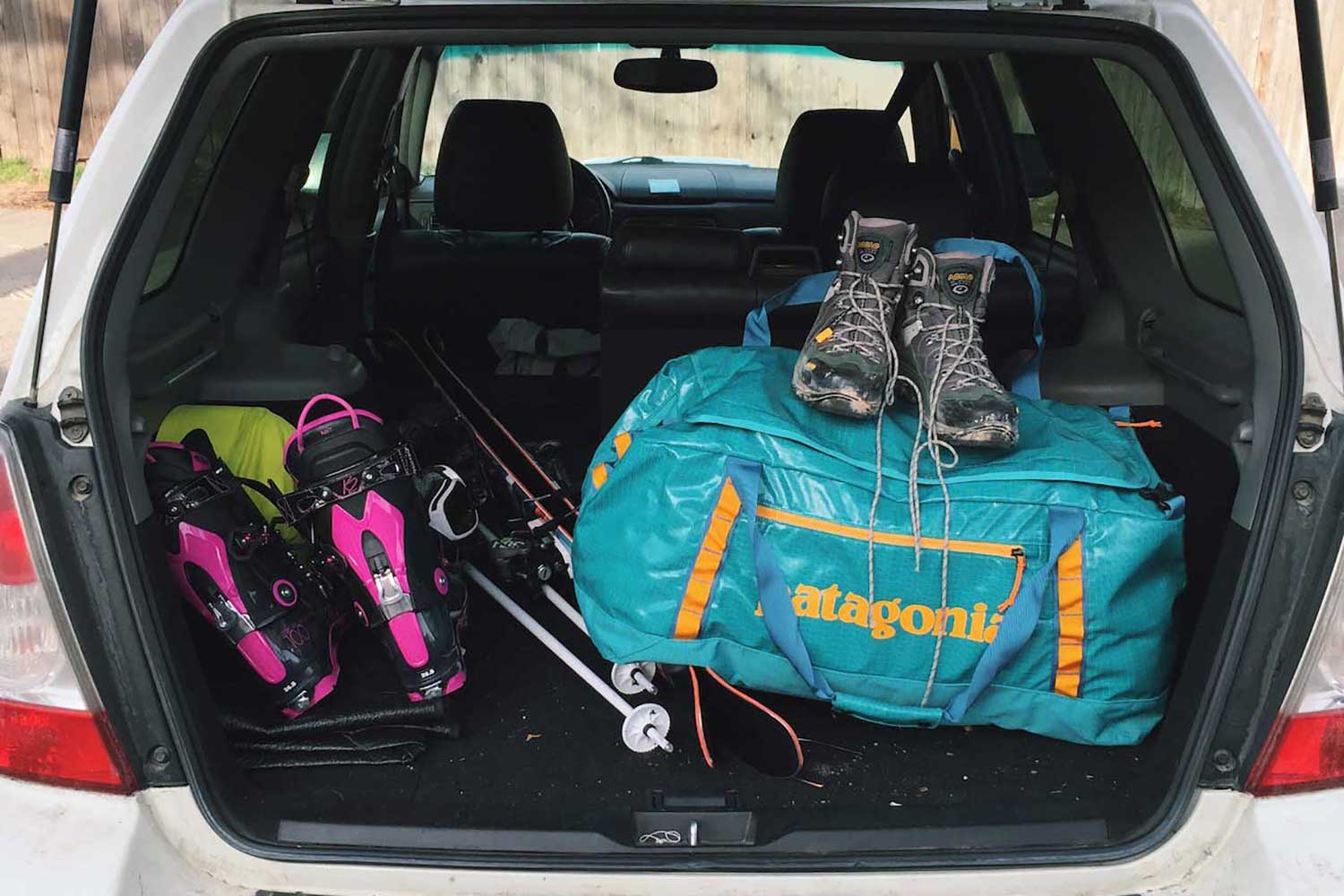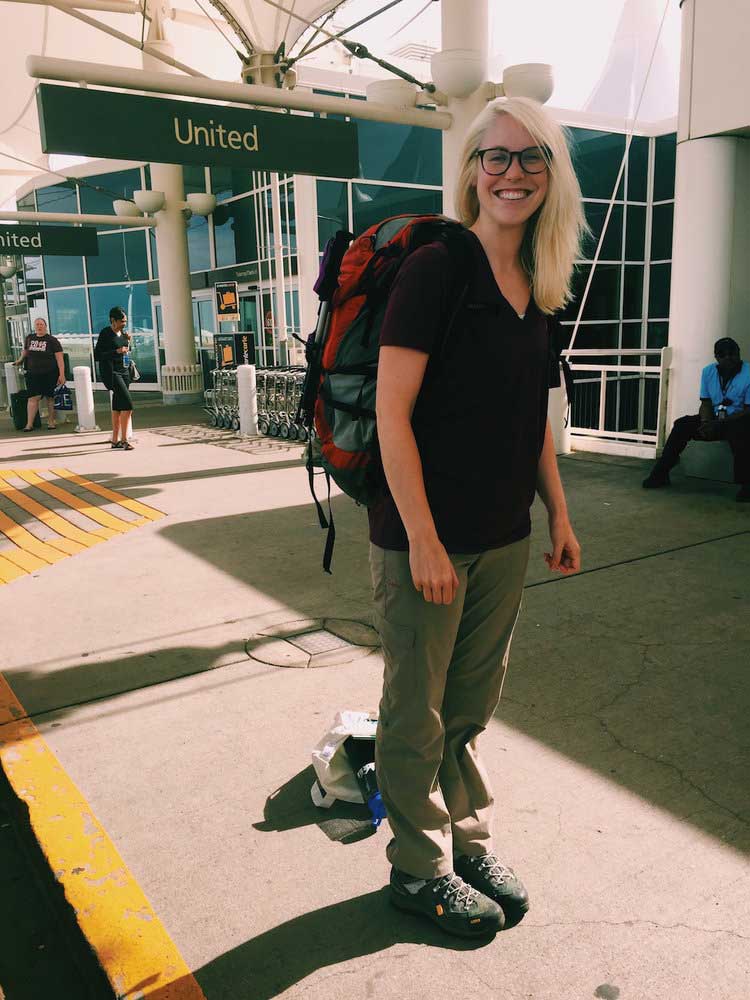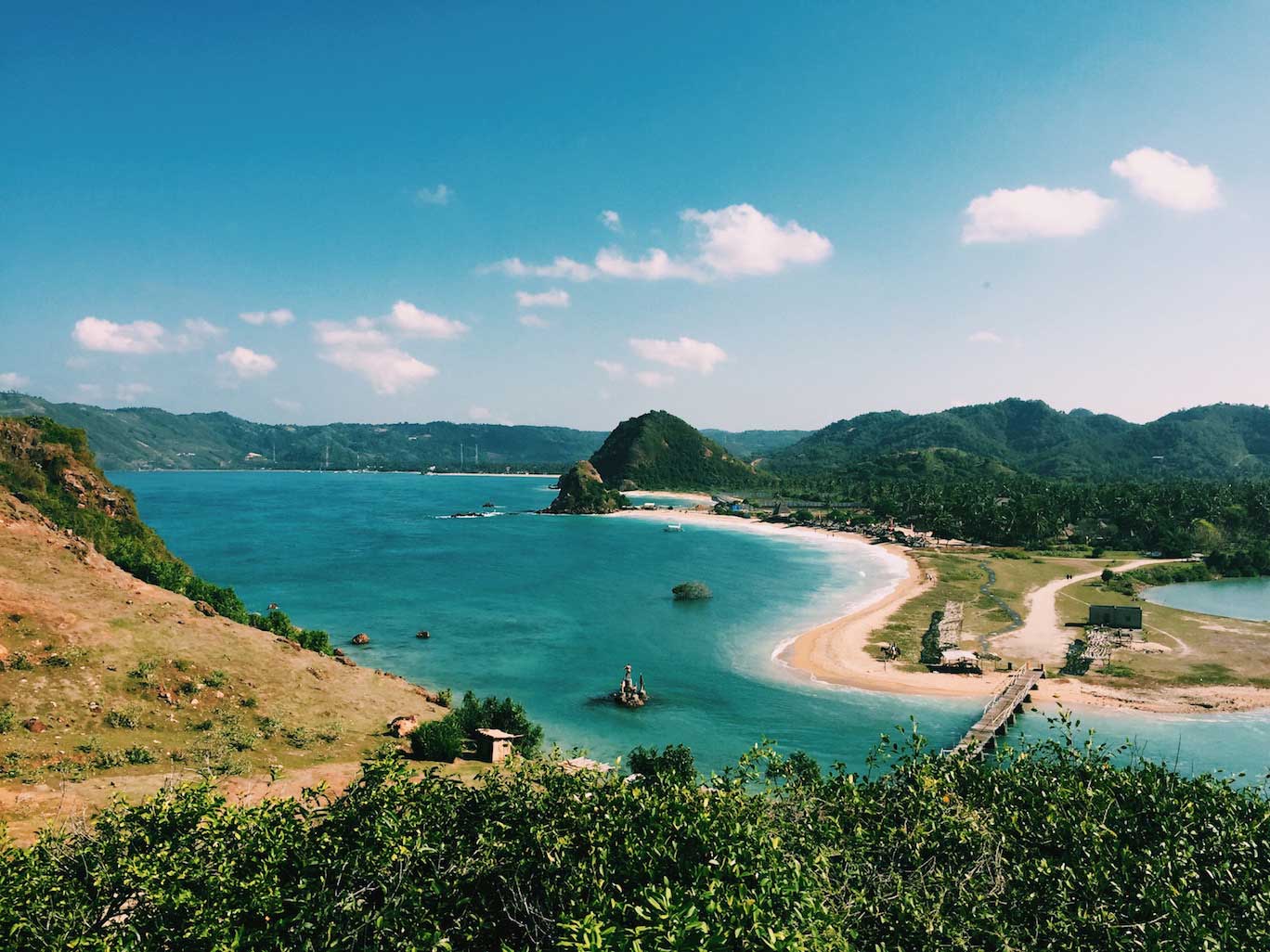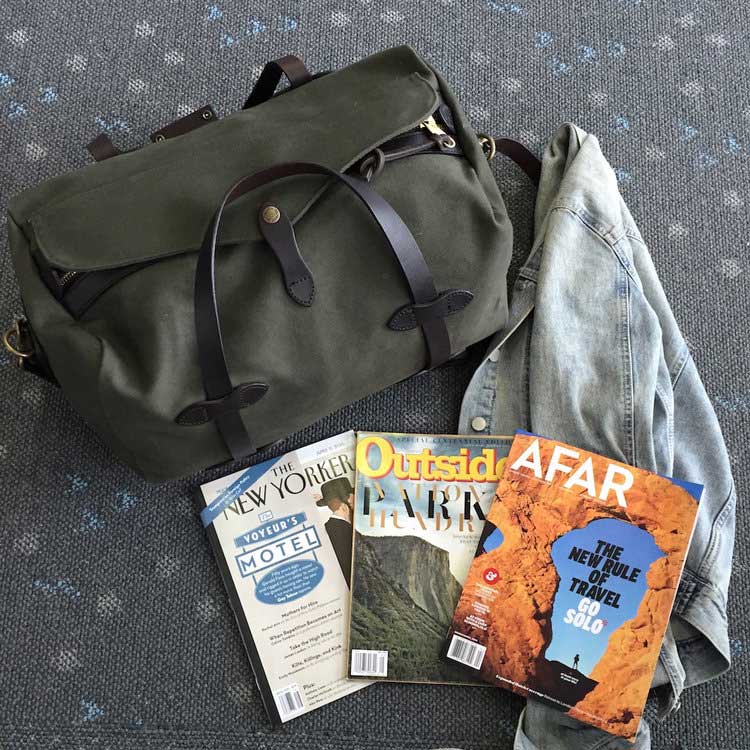Structured Spontaneity | Packing for Your Next Big Adventure

Structured Spontaneity
Packing Advice for Your Next Big Trip
By Haley Littleton
I was two weeks out from a trip to South Asia and glancing across travel alerts when it struck me: “malaria pills!” After calling several clinics across the Denver Metro area and shifting my work schedule around, I finally squeezed a last minute appointment in for vaccinations and the pills. Suffice to say: I was cutting it close. While I was most likely not going to get malaria from the village I was traveling to, my perspective on traveling (along with backcountry preparation) is that you never know.
Preparation might feel like overkill but, in the case of traveling abroad, a few extra steps make the difference between a helpless tourist looking around in a daze and a confident female traveler on a mission. This is not to fear the world we venture out into, an emergency can strike at the café around the corner from your house or on a busy street in the heart of Jakarta, but a few extra steps of packing can leave you prepared and the transitions of your trip a breeze. A friend, who travels extensively solo, and I call this “spontaneity within a structure:” the structure of pre-trip preparation and a plan can open up the most exciting and whimsical derails that don’t leave you stranded in the middle of a foreign country. Below you will find several planning steps that will help you map out your next big expedition. I suggest creating a master list on your computer and checking things off as you go.
I. Preliminary Research
Country Research
 Traveling abroad, especially to more remote and non-Western locations, can require a lot of extra research and preparation. I always begin by checking the U.S. Department of State website to see if there are any travel alerts, political and medical situations, or other information about the countries I’m traveling to. These travel alerts will also let you know what medications or immunizations are recommended for your area of travel. A lot of hospitals also have travel clinics that will consult you on any medical issues along the way and helpful in-country tips (water sources, food safety, etc). In traveling to Indonesia, my travel nursed warned me: “If you get bitten by a monkey, you will have to be airlifted to Singapore for a rabies vaccine so be careful.” Certainly a helpful insider tip.
Traveling abroad, especially to more remote and non-Western locations, can require a lot of extra research and preparation. I always begin by checking the U.S. Department of State website to see if there are any travel alerts, political and medical situations, or other information about the countries I’m traveling to. These travel alerts will also let you know what medications or immunizations are recommended for your area of travel. A lot of hospitals also have travel clinics that will consult you on any medical issues along the way and helpful in-country tips (water sources, food safety, etc). In traveling to Indonesia, my travel nursed warned me: “If you get bitten by a monkey, you will have to be airlifted to Singapore for a rabies vaccine so be careful.” Certainly a helpful insider tip.
Along with this, check to see what the visa requirements are. Some countries offer 30 day tourist visas or 90 day tourist visas and others require a fee. Knowing these restrictions can help you plan a longer trip around what route to take. For example, the Schengen area (most European countries) has open borders but only allow a 90-day visitation period. Once you use up your 90 days, you must wait another 90 days to visit this region. Other countries only require that you briefly leave the country before re-entering. Take the necessary steps to plan ahead so you don’t risk a confusing conversation with border control. I would also do research on cultural norms for the region: is there an expected formality of dress? Do you tip? How should you accept gifts? What is the most polite way of going about your travels? I’ve found that knowing these things can lead you to having incredible experiences with locals who are willing to show you around their cities because you made the extra effort to communicate and connect with them.
Money and Insurance
Make sure that you call your banks to alert them of where and when you will be traveling. I always suggest getting in touch with a real person rather than an automated system or email. I’ve had one or two situations where my request did not go through, and I ended up in country with my card declined at an ATM. I always research whether airports or hotels will have ATMs because you tend to get the best exchange rates there rather than currency counters.
While this will most likely not happen, have a plan in the case that your wallet is stolen. Is there a Western Union you can go to? Do you have enough cash? When living in Amsterdam, my wallet was stolen while I was in the park. I have yet to figure out how they managed this, but I had to resort to a call home and a desperate trip to a Western Union. I’m also an advocate for traveler’s insurance, like World Nomads who assess your claim based on the country you’re traveling to and the length of your stay. It’s a nice assurance to know that you have insurance to cover emergency evacuation, hospital stays, and stolen baggage/equipment.

Communication and Accommodations
I always plan ahead to make sure that I will be accessible. You can either rely on the Wi-Fi of the places you are staying at and traveling to or purchase a SIM card when you get to your destination. When it comes to communication, I make sure a few people know where I am traveling to and that I have the contacts for the embassy in the country. Circling back to the Department of State, a great program recently developed is STEP (Smart Traveler Enrollment Program). By putting in your phone number, email, and where you are traveling to, the Department of State knows where you are traveling and will immediately contact you in the case of a natural disaster, political situation, or a family emergency, along with contacting your emergency contacts. While it may seem excessive, having the US Embassy know that you are in their country can be a huge help in your travel and plans.
Aside from that, I always acquaint myself with the basic layout of the country, their transportation options, and certain sites that I want to visit. When it comes to accommodations, plan head as much as possible. If you can’t immediately book rooms or hostels, at least know several places in the area that you are traveling to where you could stay. It’s no fun to wander around a city street at 12 am looking for a bed to sleep in… (Here’s looking at you Paris in July).
II. Documentation
Lifesaver Folder
In preparation for trips, I create a master folder that contains the documents that I need for my travel, and I guard it like a hawk. As much as I can, I keep this folder on my person in my day-to-day bag or many hostels and hotels offer safes that you can place these things in, whether it is in the room or behind the desk. If the paper folder gives you travel anxiety and you have your iPhone/computer/tablet with you, you can easily scan these documents into a Google Drive account that you can quickly access. First, I make several copies of my passport in the off chance that I misplace it or it is stolen to ensure that I can keep traveling. I make copies of my driver’s license and insurance cards. I also make copies of the fronts of my cards and make sure that I have the security codes memorized. In the folder I organize all of my flight itineraries, hotel reservations, guide/activity confirmations, and directions and phone numbers for cab/Uber drivers. If I’ve purchased traveler’s insurance, I include a copy of my policy and their 24-hour phone numbers. I also create “cheat sheets” for myself with helpful phrases in the native language, quick conversion math, and emergency contact information. This is the smallest detail but I always list U.S. phone numbers beginning with the country code (+1) so that someone in country could easily make a call. If you won’t have the map on your phone, include a country map or a map of the wilderness area you are visiting.
III. Packing
Toiletries and Medication
 This section is completely dependent upon where you are traveling, the nature of your visit (wilderness expedition vs. city) and for how long. I always buy shampoo and conditions in country to avoid having to check a bag. For carry on, I put everything I need in a large Zip-Loc bag that I can easily remove for security screening and usage. I always keep a toothbrush, toothpaste, and dry shampoo in my carry-on so that I can brush my teeth after a long international flight. It’s the little things, like clean teeth, that can help you get through a 24-hour travel day. Some countries, when it comes to feminine needs, do not have as many options as the U.S. so I always bring a few things if I think I might need them. When it comes to toiletries, especially for outdoor expeditions, REI has a great amount of carry-on sized toiletries and medication. As for medication, I bring a small first-aid kit, with plenty of moleskin and Advil, because you can get just as many blisters wandering the humid streets of Rome as you can the backcountry of Patagonia. If going to a country with a different type of food than at home, I bring rehydration tablets and Imodium for diarrhea. I always carry a “just-in-case” prescription of Cipro to treat dire cases of diarrhea or UTIs. Cipro, however, can cause tendon tears so, if engaging in intense activity, only take it if you are going to have a rest day or two and is absolutely necessary.
This section is completely dependent upon where you are traveling, the nature of your visit (wilderness expedition vs. city) and for how long. I always buy shampoo and conditions in country to avoid having to check a bag. For carry on, I put everything I need in a large Zip-Loc bag that I can easily remove for security screening and usage. I always keep a toothbrush, toothpaste, and dry shampoo in my carry-on so that I can brush my teeth after a long international flight. It’s the little things, like clean teeth, that can help you get through a 24-hour travel day. Some countries, when it comes to feminine needs, do not have as many options as the U.S. so I always bring a few things if I think I might need them. When it comes to toiletries, especially for outdoor expeditions, REI has a great amount of carry-on sized toiletries and medication. As for medication, I bring a small first-aid kit, with plenty of moleskin and Advil, because you can get just as many blisters wandering the humid streets of Rome as you can the backcountry of Patagonia. If going to a country with a different type of food than at home, I bring rehydration tablets and Imodium for diarrhea. I always carry a “just-in-case” prescription of Cipro to treat dire cases of diarrhea or UTIs. Cipro, however, can cause tendon tears so, if engaging in intense activity, only take it if you are going to have a rest day or two and is absolutely necessary.
Recommendations:
- If you’re traveling to a place where you need to guard against mosquitoes, I’m a fan of the Premethrin clothing treatment, which virtually kept all bugs away from me, and Ultrathon’s 12-hour lotion, a quick and easy application that doesn’t leave your skin feeling gross.
- When it comes to feminine needs, I am a loyal convert of the“Diva Cup” because of its 12 hour span, environmentally friendly design, and easy packing/clean up. I suggest doing your own research, but I’ve found it be a life-saver.
- For toiletries, I always carry “Not Your Mother’s Clean Freak Dry Shampoo” because it’s cheap, and Target always has smaller, travel versions of it.
- For first aid kits, I like to buy the Adventure Medical Kits” because they have a lot of different versions for different situations.
- For rehydration tablets, I stick the packable “Nuun Active” tablets that come in different flavors.
Clothing and Gear
This is a section that is also dependent on your travel details, but if you are trying to carry-on your entire luggage, be ruthless about clothing options. I tend to wear my heaviest articles on the plane and then take them off once I get on. Look for ways to mix-and-match and layer your clothing. I always roll clothing for extra space and, if I’m using a backpacking pack, use two dry bags for dirty and clean clothing.

My go-to’s:
- For packs, I’m loyal to Osprey for their durability (my 65L has lasted six years so far) and comfort.
- When it comes to clothing, I use Patagonia’s Capilene or Merino wool base layers and their active underwear because of their quick drying capacity. I have almost worn out my Fjallraven trekking pants and like their ability to transition from mountainside to dirtbag-in-the-city.
- As for rain jackets, Outdoor Research’s Helium II is incredibly packable (at 5.5 ounces), 100% waterproof, and breathable.
- Finally, for shoes, I never travel without my Chacos (though I did get laughed at in Rome), Solomon Sense Pros, and Asolo Revert Hiking Boots.
Often when traveling, there are plenty of places geared towards doing laundry for backpackers or cheap Laundromats where you can wash your clothing. I pack a small extra bag for trinkets and small souvenirs, for this is always means ceramics and local delicacies, but consider what airports will let you carry on. Once, at the Atlanta airport, security took my Speculaas Cookie Butter from me as I was exiting the airport, and I wanted to cry. Gear is also dependent on where and when you are traveling but I always bring my Black Diamond Revolt headlamp with me, even to Europe. I like having it to read in hostels so I don’t disturb other travelers. I also bring an extra towel just in case and plenty of contacts along with my glasses.
There is much more to be said about tips once you get to where you’re going, especially when navigating as a female traveler, and tips to find the best local hideouts. For now, structured preparation and organization can lead take unexpected and spontaneous turns with excitement rather than risk.
Find Haley Littleton on Instagram and read more of her writing on her website.
Editor’s Note: This article contains affiliate links, which help support She Explores. For every purchase you make through an affiliate link, She Explores earns a small commission at no charge to you.
Be the first to comment